There is an extremely wide choice of exciting drawing materials available which can be overwhelming for the beginner. My advice is to keep your initial selection of tools and equipment simple. Buy the best that you can afford and add to your collection as your confidence grows.
Pencils:

Flowers and plants can be drawn successfully in a diversity of
media, but to begin with I suggest that you choose the humble pencil.
Pencils are the most versatile of drawing instruments and capable of
an extraordinary variety of marks. They range from the hard 9H through
the middle-of-the-range HB, to the softest, 9B.
Propelling pencils and clutch pencils are available in hard and soft leads and are very useful for sketching; also, they don’t need endless sharpening.
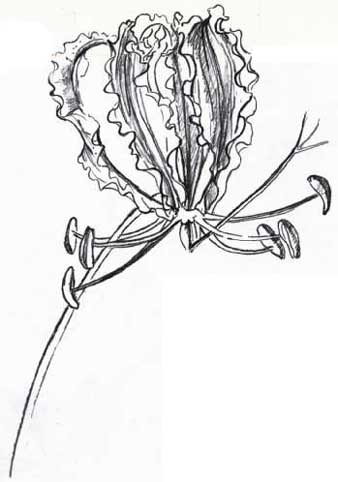
Used dry, a dark water soluble pencil on cartridge paper is an
excellent combination for sketching the waxy petals of a lily head (above).
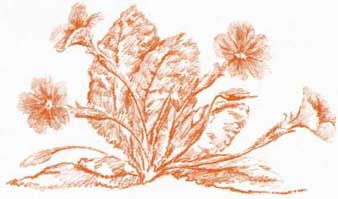
This tonal drawing of a primrose (below) was drawn using a mixture
of 9B and 4B graphite pencils on rough cartridge paper.
Remember always to carry a knife or pencil sharpener with you, as the softer pencils wear down very quickly. Explore the potential of as many different pencils as possible, and the effects they create. Don’t be afraid to smudge and gently erase areas, combine soft pencils with hard, and moisten your water-soluble pencils.
Pens:
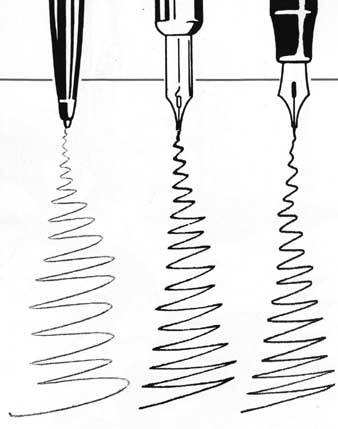
There are a variety of pens on the market producing a wide range of effects.
Felt-tipped pens come in an enormous selection of line widths and colors. Do experiment with the combination of wide and fine tips; the wide tips, For example, are good for defining the petals of a daisy, while the fine tip describes the petal’s fine veins.
Technical pens are invaluable if you wish to take a more botanical approach to your flower drawing. Their nibs come in different thicknesses of line, the finer the line the lower the number. They need careful washing after use as their fine nibs become easily clogged.
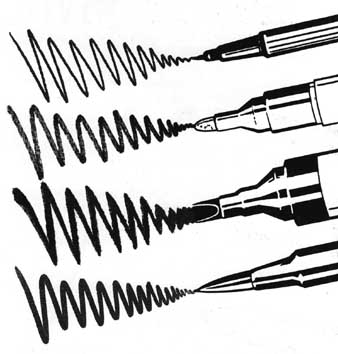
Dip pens are also pleasant to use and there is an interesting range of both fine- and square-tipped nibs available. Experiment with square-tipped nibs for the flower stalks and use the finest nib of all — the mapping pen — for describing the flower stems.
Fountain pens have different-colored cartridges and are a delight to take sketching, giving continuous line in various sepias, blacks and blues.
Ballpoint pens are a variety of pen I would avoid. Although they move swiftly over the paper, they are inclined to leak, smudge unpleasantly and are generally rather messy.
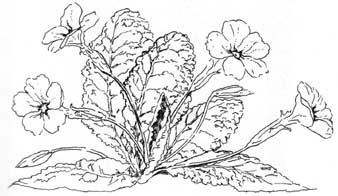
The same primrose as the one opposite: here the crisp, precise
lines of technical pen create a quite different look.

Pastels and crayons:
These offer an exciting alternative to the more precise line of pens and pencils, Pastels produce a rich, crumbly line. They work best on a rough or textured paper. To begin with, I suggest that you buy a small box or a few single sticks. You might also like to try pastel pencils; they are much harder and can be sharpened with a knife.

The character of a flower can be caught by a few bold strokes of
pastel.
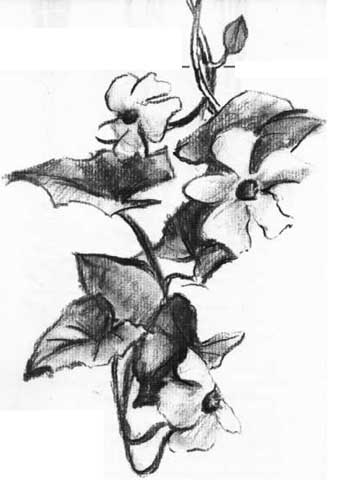
The powdery line of the pastel chalk can be blended with a paper torchon and smudged with a clean finger. It’s ideal for large-scale work. For smaller-scale detail, chalks can be broken into smaller pieces; they can also be used on their sides or their tips.
Conté crayon has a distinctive crisp line and is easy to blend.
Wax crayons and oil pastels are rather greasy media which make mistakes difficult to erase. They come in a dazzling array of colors, but need to be handled carefully to avoid overworking.

Charcoal and graphite:
Both of these are versatile media. For a really bold approach to drawing flowers, choose charcoal. Charcoal is one of the oldest and most traditional of drawing implements.
Charred charcoal twigs encourage a loose and free style of drawing. They are particularly useful for preliminary sketches and are always used in conjunction with pastel at the beginning of a pastel drawing. The charcoal stick may be used from every angle, with varying effects. Though not a delicate medium, it can be sharpened to a point on fine sandpaper. Pressure on the point will result in drawings of velvet black, while broken pieces used on their sides will produce delightful tonal qualities in shades of grey. Don’t absent-mindedly rest your hand on your drawing as charcoal smudges very easily. Always spray your drawings with hair spray or fixative.
Compressed charcoal is another alternative to the charcoal twig. It comes in both pencil and stick form and is cleaner to handle. The resulting drawings are often darker in tone. Do experiment by using both together.
Graphite stick is a favorite medium. These chunks of pencil lead are available in various softness. They can be used at speed for gestural drawings, or sharpened to a point for more detailed work.
The side and point of a 9B graphite stick was used to define the petal shapes of this rose while the graphite point was used delicately to sketch the leaves.
TIP: To keep fingers and colors clean, always have a box of tissues - nearby for wiping away smudges when using pastel chalks, charcoal and conté crayon.
Brushes and wet media
There is a wide range of brushes on the market. Because they vary so much in size, shape and quality, it’s difficult for the beginner to make the right choice. Always buy the highest quality that you can afford and try at least to have one sable in your collection. It will last for years, and if looked after will never lose its shape. Also include some synthetics, particularly if you are going to use waterproof ink and acrylic paint.
Buy a small selection of variously shaped brushes. I suggest one round No. 4 for creating generous washes, a pointed No. 1 and No. 2 for fine lines, and a square-tipped No. 3 which is invaluable for flat, controlled areas. All brushes need careful washing after use, especially after use with waterproof ink or acrylic paint, which can dry hard.
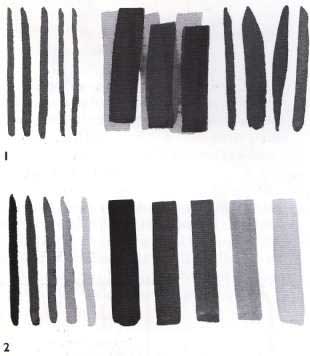 1 These brushmarks were made with (from left to right) a small, pointed
brush; a flat brush; and a large, pointed brush.
1 These brushmarks were made with (from left to right) a small, pointed
brush; a flat brush; and a large, pointed brush.
2 Watercolor tones can be progressively reduced by adding more water, as shown by these strokes using different dilutions.
3 For an even layer of strong watercolor, add darker washes to a light wash while still wet.

4 To prevent colors ‘bleeding’ into each other, let the first layer dry before adding the next.
5 For a soft, blurry effect, paint watercolor onto paper that has been slightly dampened.
6 Ink or concentrated watercolor on damp paper will spread into swirls and blotches.
Black ink, water, pen and brush can be combined successfully to produce traditional black line-and-wash drawings. Use waterproof ink to prevent your line drawing dissolving, and use non-waterproof Indian ink or watercolor for your wash.
As always, though, do experiment. Inks come in a bright array of colors, are easily mixed and look wonderful painted over dry black ink.
Watercolors are sold in small blocks or pans, tubes or in concentrated liquid form. Depending on the amount of water used, the colors can be as strong or as delicate as you like. Watercolors happily mix with other media, and areas of dry watercolor may be enlivened by strokes of chalk pastel, conté and oil pastel.

Oil pastel works well as a wax-resist drawing. A watercolor or water-based ink wash over the top won’t adhere to the greasy pastel, and the underlying drawing will show through.
Gouache, like watercolor, is a water-based paint, but if applied thickly is dense and opaque. It’s very useful for obliterating mistakes and will easily cover pencil and pen lines.

Acrylic paint, though it closely resembles oil paint, is water-based. It’s quick-drying and excellent for building up translucent layers of colour. There are various media that can be added to acrylics for different effects. I suggest that you try texture paste for added interest to flower petals and stamens.
When using paints and inks, always have a jug of water and at least two water containers near at hand. Change your water often to keep your colors clean. Old plates and cups are ideal for mixing inks and holding individual colors.
This bunch of Provençal lavender was painted with a No. 1 sable brush on dry watercolor paper using concentrated paint and very little water in a technique called ‘the dry brushstroke’.
Broad brushstrokes of diluted Indian ink on damp watercolor paper give this sunflower a certain spontaneity.
Tip: Use a mouth spray diffuser to ‘spatter’ ink or watercolor on dry or damp paper for interesting textural effects. Be very careful.
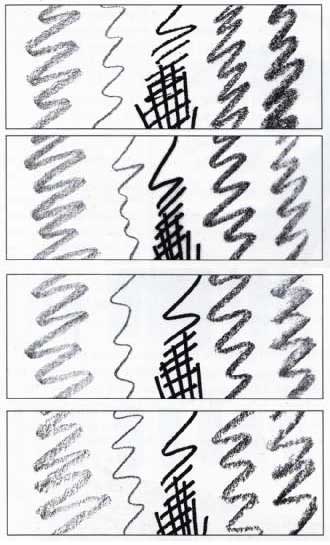 Newsprint is very inexpensive, which makes it good for practicing and
rough sketching.
Newsprint is very inexpensive, which makes it good for practicing and
rough sketching.
Tracing paper is semi transparent so that you can lay it over other images and trace them.
Stationery paper, usually available in one size, has a hard, smooth surface that works well with pen.
Cartridge paper usually has a slightly textured surface, and is one of the most versatile surfaces.
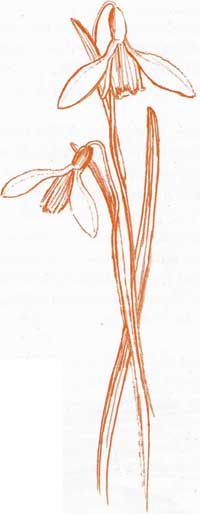
This little snowdrop was sketched with a fine, black felt-tip pen on
cream cartridge paper in a small, pocket-sized sketchbook.
Surfaces:
The texture of your paper will determine the character of your drawing. There are no strict rules about which medium to use on which surface, but some combine better than others. Pastel chalks and conté, for example, are best applied to a rough, textured paper while technical pens work better on a smoother surface. Experiment with colored papers; it’s exciting to draw with white chalk on a dark surface, while brown conté looks good on a background of rich cream.
Watercolor paper may be hand-made or machine-made and comes in three surface textures: hot-pressed, not (i.e. not hot-pressed), and rough. Watercolor paper won’t buckle when dampened and stretched.
Cartridge paper is suitable for all media, even thin applications of pastel. It’s available in rolls, sheets and sketchpads.

Ingres paper, in various colors and with a lightly ridged surface, is ideal for pastel and charcoal.
Watercolor paper is thick and absorbent, and has a rough surface. It’s good for wet media.
Bristol board is stiff and has a smooth finish that makes it a good surface for pen drawings.
Layout paper is a semi opaque, lightweight paper that is very suitable for pen or pencil drawings.
Pastel papers and boards come in many textures and colors. Their rough texture or ‘tooth’ will hold many layers of pastel pigment.
Photocopy paper and layout paper are very smooth and ideal for working in pen and ink.
Bristol board is ideal for ink washes.
Newsprint and wrapping paper are cheap, and should not be despised.
Tracing paper is very used for planning a composition and tracing a design.
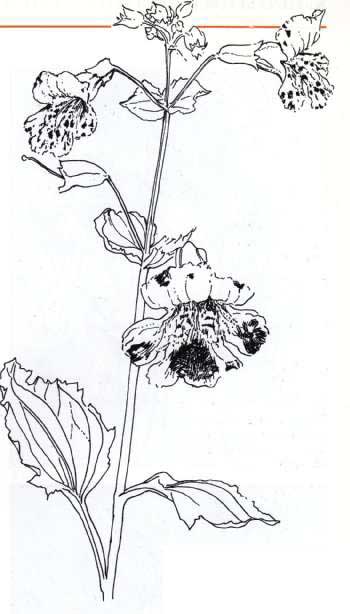
A technical pen on layout
paper is ideal for drawing the detail in this mimulus.
top of page Home Page